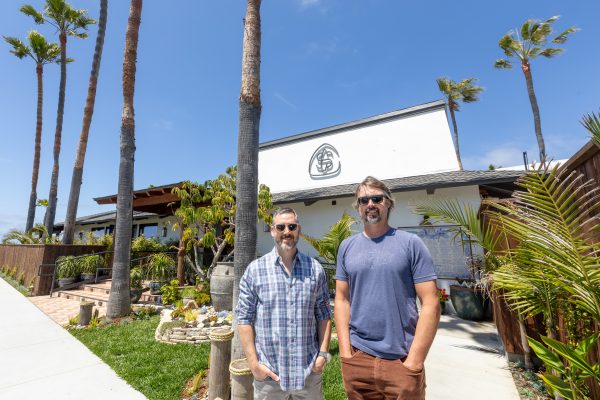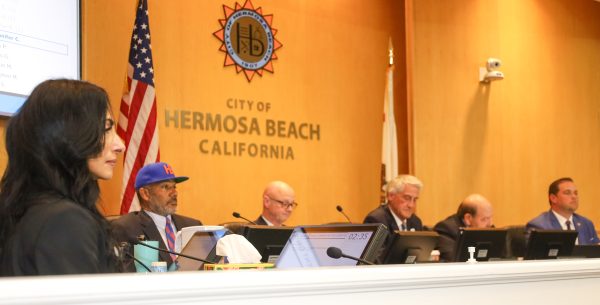
Tom Morley has been fighting oil drilling in Hermosa Beach since 1989 when he read the drilling proposal’s first Environmental Impact Report. Morley lived on Loma Drive, across the street from the proposed drilling site at Sixth Street and Valley Drive.
He wasn’t concerned about property values. The proposed site was already ugly. It was the city maintenance yard. Nor was he concerned about a blowout or other environmental damage, which he considered improbable.
Morley was an assets manager for a Fortune 200 electronics distributor, with an obsessive concern for financial details. After studying the drilling proposal, he concluded it was a money-loser for the city.

In 1994, as president of the Hermosa Beach Stop Oil Coalition, Morley went to Sacramento to make that argument to the State Lands Commission. The commission was unpersuaded and allowed Hermosa to issue a permit for drilling into the city tidelands.
The timing was significant because the following year the California Coastal Sanctuary Act was passed, banning new tidelands drilling.

The only Santa Monica Bay exceptions to the 1994 ban are a federally owned parcel in Malibu and the Hermosa Beach maintenance yard, because its lease preceded the ban, Heal the Bay vice president Sarah Sikich told an anti drilling forum two weeks ago.

In 2012, when E & B Natural Resources acquired the Hermosa drilling rights, with the condition that Hermosa voters lift the city’s drilling ban, Morley re-immersed himself in the proposal’s finances.
Hermosa oil volume studies and the recent drop in oil prices, he concluded, make drilling for oil in Hermosa’s tidelands even less promising than he had previously believed.

“Other people can argue it’s bad for the environment and property values and that oil companies are evil. To me, it’s all about volume and prices,” Morley said. “E & B’s volume estimate is six times what Redondo’s tidelands wells produced over roughly the same period of time with the same number of wells.”
E & B plans to drill 30 wells over 35 years. Redondo had 31 tidelands wells from from 1955 to 1991.

For Hermosa to break even financially, the oil volume would need to be double what Redondo recovered and be priced at $70 per barrel, Morley argued.
This analysis is among the hundreds of charts, tables and opinions Morley has posted over the past two years on his website HBOilFacts.com.
Even oil opponents who agree with his arguments find the site daunting.
After reviewing Morley’s site, former Hermosa councilman George Schmeltzer, a leader of Hermosa Beach Stop Oil, emailed Morley a quote from “Amadeus,” which Emperor Joseph II addresses to Mozart: “Your work is ingenious, it’s quality work. And there are simply too many notes…”
Dartboard projections
Morley’s “volume/price” argument is found under a tab on his site titled “Volume plus Break-even.”
The Cost Benefit Analysis prepared for the city by Kosmont Companies states that the 35-year oil lease’s “Expected Case” volume is 17.1 million barrels.
The CBA defines “Expected Case” as a 50 percent probability.
“Fifty percent is a coin flip. It isn’t an ‘expected case.’” Morley said.
A more realistic projection, Morley said, is what Kosmont labels its “Low Case” volume, which the CBA defines as a 90 percent probability.
The CBA’s Low Case volume projection is 10.9 million barrels.
E & B projects 35.6 million barrels, according the Cost Benefit Analysis.
The CBA and E & B projections are among 15 different projections presented in a report by trial expert Robert Wonderlich for the city in its lawsuit with Macpherson Oil. Macpherson was claiming up to $500 million in damages as a result of the city abrogating their drilling agreement following the 1995 vote reinstating the city’s ban on oil drilling. Morley obtained the Wonderlich report through a Freedom of Information request made to the City of Hermosa Beach.
Five projections commissioned by the city between 1984 and 1995 predicted an average volume of 5.9 million barrels over 35 years, according to the report. That number is close to the 5.6 million barrels Redondo’s tidelands produced over 30 years, Morley noted.
Five studies commissioned by Macpherson Oil investors between 1992 and 1998 forecast slightly higher volumes. Their average estimate was 8.2 million barrels over the length of the lease.
Macpherson’s five studies, conducted between 1988 and 2009, averaged 13.2 million barrels.
E & B’s 35.6 million barrel projection included oil from the Schist Zone, which only one of the other studies included. E & B’s estimate without the Schist Zone is 20 million barrels, which is close to the Kosmont CBA “Expected Case” volume (50 percent probability) of 17.1 million barrels.
Following publication of Kosmont’s preliminary CBA in March, 2014, E & B’s Vice President of Environmental and Government Affairs Michael Finch said E & B’s higher estimates was attributable, in part, to its anticipation of a 15 percent to 20 percent recovery rate. Recovery rate refers to the percent of oil in a reservoir that can be extracted. The CBA used a recovery rate of eight percent.
To counter arguments that new technology will enable Hermosa to recover more oil than Redondo did, Morley put a video clip on his website of Kosmont’s Wil Soholt telling the city council at it September 30, 2014 meeting that newer drilling technology will speed oil recovery, but will not increase the amount of oil recovered. “Think of it as shifting the bell curve to the near term,” Soholt said in response to questioning by Councilwoman Carolyn Petty.
Money everywhere, but not a dime to spend
Based on the Kosmont CBA’s “Low Case” estimate of 10.9 million barrels, Morley has calculated that oil would need to average $70 a barrel over the 35 year lease for the city to break even. Morley’s calculations include only royalties that would accrue to the general fund, which the city may spend as it wishes.
It does not include restricted Tidelands royalties.
Morley uses $38.3 million as the city’s break even point. That figure is based on the CBA estimates of $19.4 million in costs related to moving the city yard and $18.9 million for a new underground parking structure at City Hall to replace the 97 parking spaces a new city yard would displace.
A February 11 update to Kosmont’s Cost Benefit Analysis, requested by the city council in response to falling oil prices, shows the city uplands account receiving $30 million over the course of the lease, with 90 percent probability, assuming oil is $70 per barrel. But Morley countered that this figure does not include the cost of a new parking structure at the city maintenance yard and it does include $6 million added by the development agreement, which Morley believes is subject to tidelands restrictions.
“Oil has been over $70 per barrel for only six years — August 2007 to September 2008 and August 2009 to September 2014,” Morley noted.
Even assuming oil prices return to $95 a barrel, they would need to do so early in the lease, Morley said, because the CBA shows 18 to 30 percent of Hermosa’s oil (depending on volume) being recovered in the first four years of drilling.
Tidelands undertow
Because tidelands oil is expected to account for roughly 80 percent of the city’s oil royalties, how tidelands funds can be spent is central to the debate on Measure O.
The February update to the CBA to the city council shows the city receiving $67 million in tidelands revenue over the length of the lease, with a 90 percent probability at $70 per barrel.
The California State Lands Commission Public Trust Doctrine states tidelands fund spending is “generally limited to those that are water related…., and include commerce fisheries and navigation, environment preservation and recreation.
The spending must benefit all California residents, not just Hermosa residents.
The State Lands Commission has agreed to allow Hermosa to place seven percent of the tidelands royalties into its general fund. But roughly half of that must be paid to Macpherson Oil, which is entitled to 3.66 percent of all of the project’s royalties.
To understand how Hermosa might spend restricted tideland revenues, Morley filed a Freedom of Information request of the city for records on how it spends its current tidelands revenues.
Hermosa signed an agreement with TyCom Networks in 2002 to allow the company to bring its Transpacific fiber optic cable ashore at Second Street. Since then, Hermosa residents have become used to seeing Global Crossing, a large white ship, offshore several times a year maintaining the cable.
The city received $1.1 million upon signing of the agreement and receives an additional $250,000 annually. Because the cable comes ashore in Hermosa’s tidelands, a portion of these funds are subject to tidelands grant restrictions.
Each October the city must report how it has spent its TyCom tidelands revenue to the State Lands Commission.
The city has spent $863,114.80 of TyCom tidelands funds over the past seven years, according to reports Morley obtained from City Finance Director Viki Copeland. Of that amount, $552,704 went to pier renovations and $310,410 to beach restroom renovations.
Copeland told Morley the city has not spent tidelands funds on police, fire or beach maintenance.
Morley acknowledges a fondness for conspiracy theories and he has one for why E & B would invest upwards of $100 million, according to the CBA, to tap Hermosa’s tidelands.
E & B is looking beyond Hermosa’s tidelands, Morley speculated.
In his research, Morley found an exception to the 1995 California Coastal Sanctuary Act’s ban on new tidelands drilling
Section 6872.5 states, “The commission may adjust the boundaries of existing leases to encompass all of a field partially contained within the existing lease… Those parts of the field within the added area may not be developed except from upland sites or existing offshore facilities within the original lease boundaries.”
“E and B hopes to get its toe in the water of the Santa Monica Bay,” Morley speculated.
E & B’s Finch dismissed Morley’s theory as unfounded.
“We’ve had zero conversations with any other South Bay community about oil operations. I’m not sure why he would say that,” Finch said. ER











